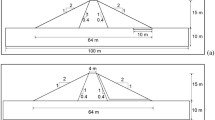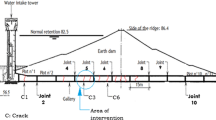Abstract
The Aznalcóllar tailings dam failure moved the Spanish authorities to pay attention to tailings deposits. The Almagrera tailings dam holds one of the largest mining waste deposits in Andalucía. The dry closure of this dam has been detailed in this manuscript. Some serious difficulties had to be solved. Firstly, the dam had undergone up to five raisings before the closure operations started, and this process had not been properly documented. Secondly, the reservoir water was contaminated by the toxic tailings placed several metres below and, due to the high acidity of this water, the geotechnical characterization of the tailings deposit has been really challenging. Thirdly, the definition of the model itself has been a complex task due to the consideration of many phases and different hypotheses. In the finite element calculation, a constitutive model of perfect non-associated plasticity has been used for the dam and a soft soil creep model for the tailings. Next, it has been decided to decontaminate a closed mine by placing its abandoned material—Las Viñas fill—on top of the tailings deposit inside the reservoir. This operation generated important settlements on the tailings deposit. These settlements had to be accelerated by placing drainage wells to avoid the cracking of the final cap. The safety factor during the dry closure operations under dynamic loading was insufficient and a compacted rockfill reinforcement had to be laid on the downstream slope of the dam. Very few papers describe a successful dry closure of a tailings dam as is done here.
Resume
La rupture du barrage de stériles d’Aznalcóllar a poussé les autorités espagnoles à prêter attention aux dépôts de résidus. Le barrage de stériles d’Almagrera abrite l’un des plus importants dépôts de déchets miniers d’Andalousie. La fermeture à sec de ce barrage est présentée dans ce manuscrit. Certaines difficultés sérieuses ont dû être résolues. Premièrement, le barrage avait connu jusqu’à cinq surélévations avant le début des opérations de fermeture et ce processus n’avait pas été correctement documenté. Deuxièmement, l’eau du réservoir a été contaminée par les résidus toxiques placés plusieurs mètres plus bas et, en raison de la forte acidité de cette eau, la caractérisation géotechnique du gisement de résidus a été très difficile. Troisièmement, la définition du modèle lui-même a été une tâche complexe en raison de la prise en compte de nombreuses phases et d’hypothèses différentes. Dans le calcul par des éléments finis (EF), un modèle constitutif de plasticité parfaite non associée a été introduit pour le barrage et un modèle visqueux pour les déchets miniers. Ensuite, il a été décidé de décontaminer une mine à proximité—Las Viñas—en plaçant son matériau abandonné au-dessus du dépôt de résidus à l’intérieur du réservoir. Cette opération a généré d’importants tassements sur le dépôt de résidus. Ces tassements ont dû être accélérés en plaçant des puits de drainage pour éviter la fissuration de la couverture finale. Le coefficient de sécurité (CS) à la fin des opérations de fermeture à sec sous chargement dynamique était insuffisant et des renforts d’enrochement compactés devaient être posés sur la pente aval. Pas beaucoup d’articles décrivent une fermeture à sec réussie d’un barrage de stériles comme cela est. fait ici.








Similar content being viewed by others
References
AGU (2017) Mishor Rotem-another tailings dam failure, this time in Israel. The Landslide blog, AGU Blogosphere. https://blogs.agu.org/landslideblog/2017/07/07/mishor-rotem-1/
Alonso EE, Gens A (2006a) Aznalcóllar dam failure. Part 1: field observations and material properties. Géotechnique 56(3):165–183. https://doi.org/10.1680/geot.2006.56.3.165
Alonso EE, Gens A (2006b) Aznalcóllar dam failure. Part 3: dynamics of the motion. Géotechnique 56(3):203–210. https://doi.org/10.1680/geot.2006.56.3.203
Álvarez-Valero AM, Sáez R, Pérez-López R, Delgado J, Nieto JM (2009) Evaluation of heavy metal bio-availability from Almagrera pyrite-rich tailings dam (Iberian Pyrite Belt, SW Spain) based on a sequential extraction procedure. J Geochem Explor 102:87–94
Barnekow U, Jakubick, A, Paul, M et al. (2003) Stabilization and decommissioning of the Sillamae radioactive tailings pond, Estonia. 10th international conference on tailings and mine waste, Vail, Colorado, pp 487–494
Brinkgreve RBJ, Bakker HL (1991) Non-linear finite element analysis of safety factors. In: Beer, Booker and Carter (eds) Computer methods and advances in geomechanics. Balkema, Rotterdam
Brinkgreve RBJ, Kumarswamy S, Swolfs WM (2016) Plaxis 2016. Delft, Netherlands
Cheng YM, Lansivaara T, Wei WB (2007) Two-dimensional slope stability analysis by limit equilibrium and strength reduction methods. Comput Geotech 34:137–150
Chief Inspector of Mines (2015) Mount Polley mine tailings storage facility breach (August 4, 2014). Investigation report (November 30, 2015). Mining and Mineral Resources Division, Ministry of Energy and Mines of British Columbia
Comité nacional Español de Grandes presas (1999) Estudios geológicos-geotécnicos y de prospección de materiales. Comité Nacional Español de Grandes Presas, Madrid
Copeiro-Villas JR, Navarro-Vázquez, D (1982) Memoria explicativa de la hoja geológica de Valverde del Camino (n° 960). 2ª serie. I.G.M.E. Madrid
Davies MP (2002) Tailings impoundments failures: are geotechnical engineers listening? Geotech News Sept:31–36
Davies MP, Martin, TE (2000) mine tailings dams: when things go wrong. Tailings dams 2000, proceedings ASDSO conference, Las Vegas
Dawson EM, Roth WH, Drescher A (1999) Slope stability analysis by strength reduction. Géotechnique 49(6):835–840
Directive 67/548/EEC (1967) Directive on the approximation of laws, regulations and administrative provisions relating to the classification, packaging and labelling of dangerous substances. Council of the European union
Directive 91/689/EEC (1991) Council directive 91/689/EEC of 12 December 1991 on hazardous waste. Council of the European Union
Directive 1999/45/EC (1999) Directive 1999/45/EC (1999) of the European Parliament and of the Council of 31 May 1999 concerning the approximation of the laws, regulations and administrative provisions of the Member States relating to the classification, packaging and labelling of dangerous preparations. Off J Eur Communities, L 200/1 to L 200/68
Gens A, Alonso EE (2006) Aznalcóllar dam failure. Part 2: stability conditions and failure mechanism. Géotechnique 56(3):185–201
Griffiths DV, Lane PA (1999) Slope stability analysis by finite elements. Géotechnique 49(3):387–403
ICOLD (2013) Sustainable design and post-closure performance of tailings dams. Bulletin 153. Paris, France
Independent Expert Engineering Investigation and Review Panel (2015). Report on mount Polley tailings storage facility breach (January 30, 2015). Government of British Columbia
Justo JL (2009) Un Modelo de la presa de Almagrera. Seville, Spain. Unpublishedreport
Justo JL, Morales-Esteban A, Durand P, Vázquez-Boza M, Jiménez FA (2013) Dynamic calculation for the dry closure of Almagrera tailings dam. Proc 18th Int Conf Soil Mech Geotech Eng Paris 2:1511–1514
Justo JL, Jiménez FA, Justo EJ, Vázquez-Boza M, Soriano C, Castilla J (2014) Estudio de los residuos mineros de la presa de Almagrera por medio de piezoconos. Ingeniería Civil, Cedex, Madrid, Spain 173:43–53
Larrauri PC, Lall U (2018) Tailings dams failures: updated statistical model for discharge volume and runout. Environments 5: 28. https://doi.org/10.3390/environments5020028
Ministerio de Agricultura, Pesca, Alimentación y Medio Ambiente (2011a) Borrador de norma técnica de seguridad para la clasificación de las presas y para la elaboración e implantación de los planes de emergencia de presas y embalses
Ministerio de Agricultura, Pesca, Alimentación y Medio Ambiente (2011b) Borrador de norma técnica de seguridad para el proyecto, construcción y puesta en carga de presas y llenado de embalses
Ministerio de Fomento (2002) NCSR-02 “Norma de construcción sismorresistente: parte general y edificación”. Madrid, Spain
Nocete F, Álex E, Nieto JM, Sáez R, Bayona MR (2005) An archaeological approach to regional environmental pollution in the south-western Iberian peninsula related to third millennium BC mining and metallurgy. J Archaeol Sci 32:1566–1576
Rico M, Benito AR, Díez-Herrero A, Pereira HG (2008a) Reported tailings dam failures: a review of the European incidents in the worldwide context. J Hazard Mater 152(2):846–852. https://doi.org/10.1016/j.jhazmat.2007.07.050
Rico M, Benito AR, Díez-Herrero A (2008b) Floods from tailings dam failures. J Hazard Mater 154(1–3):79–87. https://doi.org/10.1016/j.jhazmat.2007.09.110
Royal Decree 975/2009 (2009) Real Decreto 975/2009, de 12 de junio, sobre gestión de los residuos de las industrias extractivas y de protección y rehabilitación del espacio afectado por actividades mineras. Ministerio de la Presidencia, BOE núm. 143, de 13 de junio de 2009, Government of Spain
Saad B, Mitri H (2011) Hydromechanical analysis of upstream tailings disposal facilities. J Geotech Geoenviron 137(1):27–42
Sáez R, Pascual E, Toscano M, Almodóvar GR (1999) The Iberian type of volcano sedimentary massive sulphide deposits. Mineralium Deposita 34:549–570
Schermerhorn LJG (1971) An outline of the stratigraphy of the Iberian Pyrite Belt. Boletín Geológico Minero 82:239–268
Sitharam TG, Hegde A (2017) Stability analysis of rock-fill tailing dam: an Indian case study. Int J Geotech Eng 11(4):332–342
Tornos F (2006) Environment of formation and styles of volcanogenic massive sulfides: the Iberian Pyrite Belt. Ore Geol Rev 28:259–307. https://doi.org/10.1016/j.oregeorev.2004.12.005
Van Niekerk HJ, Viljoen MJ (2005) Causes and consequences of the Merriespruit and other tailings-dam failures. Land Degrad Dev 16:201–212. https://doi.org/10.1002/ldr.681.
Yin G, Li G, Wei Z, Wan L, Shui G, Jing X (2011) Stability analysis of a copper tailings dam via laboratory model tests: a Chinese case study. Miner Eng 24:122–130. https://doi.org/10.1016/j.mineng.2010.10.014
Yin G, Zhang Q, Wang W, Chen Y, Geng W, Liu H (2012) Experimental study on the mechanism effect of seepage on microstructure of tailings. Saf Sci 50:792–796. https://doi.org/10.1016/j.ssci.2011.08.032
Zabala F, Alonso EE (2011) Progressive failure of Aznalcóllar dam using the material point method. Géotechnique 61(9):795–808. https://doi.org/10.1680/geot.9.P.134
Zandarín MT, Oldecop LA, Rodríguez R, Zabala F (2009) The role of capillary water in the stability of tailing dams. Eng Geol 105:108–118. https://doi.org/10.1016/j.enggeo.2008.12.003
Zienkiewicz OC, Humpheson C, Lewis RW (1975) Associated and non-associated visco-plasticity and plasticity in soil mechanics. Géotechnique 25(4):671–689
Acknowledgements
The help provided by the Spanish Ministry of Science and Innovation through the project BIA2010-20377 and by the Instituto Universitario de la Construcción y Arquitectura for revising the English are acknowledged.
Author information
Authors and Affiliations
Corresponding author
Rights and permissions
About this article
Cite this article
Justo, J.L., Morales-Esteban, A., Justo, E. et al. The dry closure of the Almagrera tailings dam: detailed modelling, monitoring results and environmental aspects. Bull Eng Geol Environ 78, 3175–3189 (2019). https://doi.org/10.1007/s10064-018-1342-2
Received:
Accepted:
Published:
Issue Date:
DOI: https://doi.org/10.1007/s10064-018-1342-2




